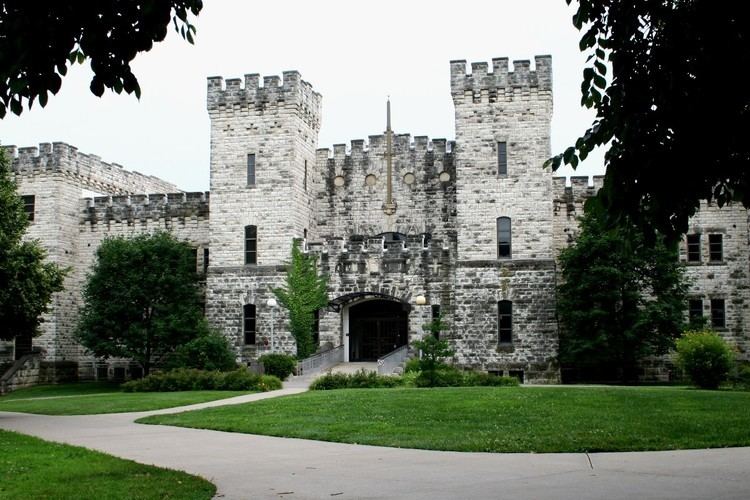Former names Nichols Court Completed 1911 Floors 3 Renovated 1985 | Type Academic Building Opened 1911 Phone +1 785-532-6875 | |
 | ||
Current tenants College of Arts and SciencesCollege of Engineering Address 702 Mid-Campus Dr, Manhattan, KS 66506, USA Architectural style Renaissance Revival architecture Similar Ahearn Field House, Anderson Hall, K‑State Student Union, Marlatt Hall, Durland–Rathbone–Fiedler Hall | ||
Kentucky wildcats tv leslie nichols hall of fame
Nichols Hall is a building on the campus of Kansas State University. This building was originally built in 1911 and appears from the exterior as a castle with battlements. Its interior was destroyed by fire in 1968, and was rebuilt in 1985. The building currently houses the departments of Computing and Information Sciences, Communication Studies, and Theatre and Dance.
Contents
- Kentucky wildcats tv leslie nichols hall of fame
- Fresh inc 2013 nichols hall john dorhauer puzzle lunch tulips cheezborger
- History
- Construction
- Early uses
- The Nichols Hall fire
- Rebuilding Nichols Hall
- Nichols Hall today
- References
Fresh inc 2013 nichols hall john dorhauer puzzle lunch tulips cheezborger
History
At the start of the 20th century, the two major needs of the Kansas State University campus were a livestock pavilion and a gymnasium. The president of the University, E. R. Nichols, lobbied hard for money for these projects and the gymnasium was christened Nichols Hall in his honor when he retired in 1909.
Construction
The initial funding and construction of Nichols Hall was started during 1910 and finished 1911. The initial budget for the construction was $25,197. More money was allocated the following year to finish the building.
The construction of the building included state-of-the-art construction techniques. Nichols Hall was one of the first buildings in the United States to be built using continuously poured concrete floor. The concrete was mixed using horses.
Early uses
The building provided a wrestling and basketball gymnasium, and two swimming pools in the basement. The pools were segregated between men and women until 1920 when the swimming classes were integrated. The building provided facilities for physical education (now the Department of Kinesiology) and the Department of Military Science.
The building was also used for commencement ceremonies.
The second educational FM radio station in Kansas, KSDB-FM, was installed into the building in 1949. The initial broadcast strength of the station was 10 watts, which was barely enough to cover the city of Manhattan.
Due to crowding during basketball contests, the university built Ahearn Fieldhouse to house basketball, other sporting events, and commencement in 1951. Some of the facilities for the Music Department were moved into the building at that time. In particular, the music instruments and sheet music for marching band were stored in the building. Women's physical education and military science were also in the building at this time.
The Nichols Hall fire
On December 13, 1968, a fire gutted the building. The fire was started when an arsonist stacked wooden tables against the front doors of the building, poured gasoline on them, and set them ablaze. The arsonist was never apprehended. Given that the building was used for military science and the charged political environment with respect to the Vietnam War, the fire is believed to have been an act of protest.
The fire destroyed all the band instruments and sheet music inside. By an odd coincidence, the music director, Phil Hewett, happened to have the "Wabash Cannonball" in his briefcase the night of the fire. This was the only music available for the band to play in a game against Syracuse a few nights later. As a result, this song became one of the main fight songs of the University.
The total damage was estimated at a half-million dollars.
Rebuilding Nichols Hall
The building was completely destroyed, except for the stout stone walls, which remained standing empty for more than a decade after the fire. In the Spring of 1979, University President Duane C. Acker announced that he intended to raze the remnants and build a parking lot in its place. Hundreds of students spontaneously gathered in protest outside of President Acker's offices in Anderson Hall. A smaller group of students moved their protest to the halls of the Legislature in Topeka, and managed to get the funds for the demolition of the building deleted from the budget, replaced with $10,000 in funding for a feasibility study. This organic, grass-roots effort by concerned students, and the positive results of the feasibility study, convinced the University and the Legislature to appropriate approximately six-million dollars to the project, which started in 1983. The building was to be rebuilt using the existing walls.
When the builders inspected the building, it was discovered that the walls were too weak to support the structure. Thus, a new structure was built inside of the existing walls and then attached. The building's exterior walls are nearly three feet deep for this reason.
The building was constructed with a glass topped atrium, a modern theatre, and class rooms and offices. The building was reopened and rededicated on November 16, 1985. On the east wall of the atrium a large mural was commissioned by Eric Bransby titled Student Achievement. The mural depicts the various uses the building has had during its history and was dedicated on October 10, 1986.
Nichols Hall today
The building has housed the Communication Studies, Theatre, and Dance and Department of Computing and Information Sciences since it was finished in 1985. The main offices for both departments are in the building as well as a number of class rooms, research laboratories, dance studios, computing labs, and the Nichols Theatre.
